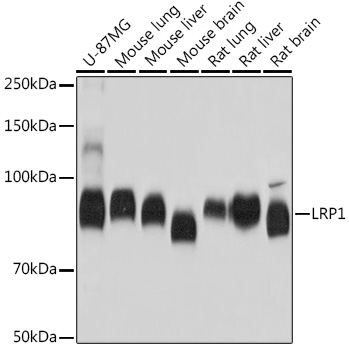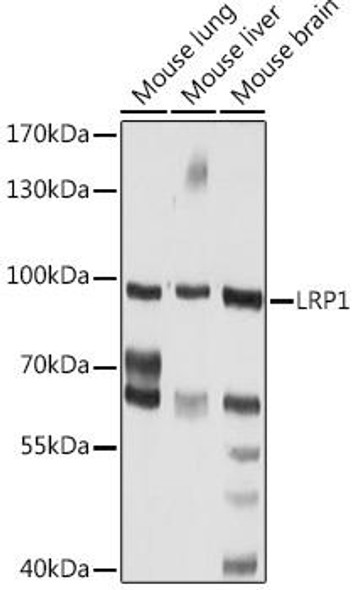Anti-LRP1 Antibody (CAB0633)
- SKU:
- CAB0633
- Product type:
- Antibody
- Reactivity:
- Human
- Mouse
- Rat
- Host Species:
- Rabbit
- Isotype:
- IgG
- Antibody Type:
- Monoclonal Antibody
- Research Area:
- Cell Biology
Description
| Antibody Name: | Anti-LRP1 Antibody |
| Antibody SKU: | CAB0633 |
| Antibody Size: | 20uL, 50uL, 100uL |
| Application: | WB |
| Reactivity: | Human, Mouse, Rat |
| Host Species: | Rabbit |
| Immunogen: | A synthesized peptide derived from human LRP1 |
| Application: | WB |
| Recommended Dilution: | WB 1:500 - 1:2000 |
| Reactivity: | Human, Mouse, Rat |
| Positive Samples: | U-87MG, Mouse lung, Mouse liver, Mouse brain, Rat lung, Rat liver, Rat brain |
| Immunogen: | A synthesized peptide derived from human LRP1 |
| Purification Method: | Affinity purification |
| Storage Buffer: | Store at -20°C. Avoid freeze / thaw cycles. Buffer: PBS with 0.02% sodium azide, 0.05% BSA, 50% glycerol, pH7.3. |
| Isotype: | IgG |
| Sequence: | Email for sequence |
| Gene ID: | 4035 |
| Uniprot: | Q07954 |
| Cellular Location: | |
| Calculated MW: | 85kDa |
| Observed MW: | 85kDa |
| Synonyms: | A2MR, APOER, APR, CD91, IGFBP3R, KPA, LRP, LRP1A, TGFBR5 |
| Background: | This gene encodes a member of the low-density lipoprotein receptor family of proteins. The encoded preproprotein is proteolytically processed by furin to generate 515 kDa and 85 kDa subunits that form the mature receptor (PMID: 8546712). This receptor is involved in several cellular processes, including intracellular signaling, lipid homeostasis, and clearance of apoptotic cells. In addition, the encoded protein is necessary for the alpha 2-macroglobulin-mediated clearance of secreted amyloid precursor protein and beta-amyloid, the main component of amyloid plaques found in Alzheimer patients. Expression of this gene decreases with age and has been found to be lower than controls in brain tissue from Alzheimer's disease patients. [provided by RefSeq, Oct 2015] |
| UniProt Protein Function: | LRP1: a receptor involved in endocytosis, phagocytosis of apoptotic cells, and neural signaling. Modulates cellular events including APP metabolism, kinase-dependent intracellular signaling, neuronal calcium signaling and neurotransmission. Involved in the plasma clearance of chylomicron remnants and activated alpha 2-macroglobulin, as well as the local metabolism of complexes between plasminogen activators and their endogenous inhibitors. Plays a fundamental role in cellular signaling pathways in the brain. Mediates neural NMDA gating via a complex of LRP1, PSD-95 and NMDAR. A type I membrane protein. After cleavage, the intracellular domain (LRPICD) is detected both in the cytoplasm and in the nucleus. Most abundant in liver, brain and lung. |
| UniProt Protein Details: | Protein type:Motility/polarity/chemotaxis; Cell surface; Membrane protein, integral; Receptor, misc. Chromosomal Location of Human Ortholog: 12q13.3 Cellular Component: focal adhesion; cell soma; clathrin-coated vesicle; lysosomal membrane; integral to plasma membrane; dendrite; cytoplasm; plasma membrane; nucleolus; coated pit; endosome; receptor complex Molecular Function:protein binding; lipoprotein transporter activity; protease binding; protein complex binding; apolipoprotein binding; calcium ion binding; receptor activity Biological Process: positive regulation of protein transport; receptor-mediated endocytosis; cell proliferation; positive regulation of lipid transport; cholesterol metabolic process; phototransduction, visible light; regulation of phospholipase A2 activity; negative regulation of Wnt receptor signaling pathway; lipoprotein transport; regulation of actin cytoskeleton organization and biogenesis; protein kinase C activation; lipoprotein metabolic process; negative regulation of neuron apoptosis; negative regulation of smooth muscle cell migration; retinoid metabolic process; regulation of cholesterol transport; apoptotic cell clearance; aging |
| NCBI Summary: | The protein encoded by this gene is an endocytic receptor involved in several cellular processes, including intracellular signaling, lipid homeostasis, and clearance of apoptotic cells. In addition, the encoded protein is necessary for the A2M-mediated clearance of secreted amyloid precursor protein and beta-amyloid, the main component of amyloid plaques found in Alzheimer patients. Expression of this gene decreases with age and has been found to be lower than controls in brain tissue from Alzheimer patients. [provided by RefSeq, Jan 2010] |
| UniProt Code: | Q07954 |
| NCBI GenInfo Identifier: | 317373384 |
| NCBI Gene ID: | 4035 |
| NCBI Accession: | Q07954.2 |
| UniProt Secondary Accession: | Q07954,Q2PP12, Q86SW0, Q8IVG8, |
| UniProt Related Accession: | Q07954 |
| Molecular Weight: | |
| NCBI Full Name: | Prolow-density lipoprotein receptor-related protein 1 |
| NCBI Synonym Full Names: | low density lipoprotein receptor-related protein 1 |
| NCBI Official Symbol: | LRP1 |
| NCBI Official Synonym Symbols: | APR; LRP; A2MR; CD91; APOER; LRP1A; TGFBR5; IGFBP3R |
| NCBI Protein Information: | prolow-density lipoprotein receptor-related protein 1; LRP-1; type V tgf-beta receptor; apolipoprotein E receptor; alpha-2-macroglobulin receptor; TbetaR-V/LRP-1/IGFBP-3 receptor |
| UniProt Protein Name: | Prolow-density lipoprotein receptor-related protein 1 |
| UniProt Synonym Protein Names: | Alpha-2-macroglobulin receptor; A2MR; Apolipoprotein E receptor; APOER; CD_antigen: CD91Cleaved into the following 3 chains:Low-density lipoprotein receptor-related protein 1 85 kDa subunit; LRP-85; Low-density lipoprotein receptor-related protein 1 515 kDa subunit; LRP-515; Low-density lipoprotein receptor-related protein 1 intracellular domain; LRPICD |
| Protein Family: | Low-density lipoprotein receptor-related protein |
| UniProt Gene Name: | LRP1 |
| UniProt Entry Name: | LRP1_HUMAN |






